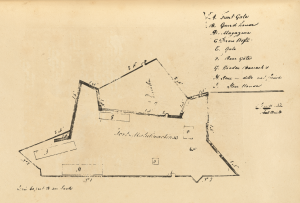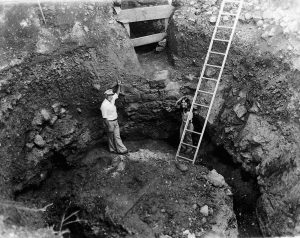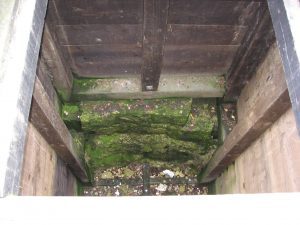
The earliest archaeological excavation at Fort Mackinac took place at one of its earliest structures, the well. When British soldiers began building Fort Mackinac in 1780, one of their first projects was to excavate a well within the fort’s walls. This required digging at least 80’ and possibly up to 150’ into the limestone bedrock. The well was still in use as late as 1800, but had failed by the beginning of the War of 1812. Over the next century and a half, the well and associated depression were filled with a variety of materials. In 1965 a team of archaeologists from the University of Michigan, led by Dr. David Brose, looked for the well, but they only had a week at the end of a project elsewhere on the island and the well proved to be further down than they expected.

In 1980, as part of the celebration of the bicentennial of Fort Mackinac, a major archaeological excavation was undertaken to search for the well. The project was carried out by a team from the University of South Florida under the direction of Dr. Roger T. Grange, Jr. He was assisted by Robin R. Wright. Her master’s thesis, The 1780 British Well Site, was the main source used in preparing this blog post. All of the filling had resulted in the remains of the well being located eight feet below grade at the end of the 1980 field season. It took another season of excavation, in 1981, to fully understand the construction and destruction series of events.
The limestone shaft of the well, 14’ in diameter at the top, was topped by a dressed stone casing. The excavation also revealed a previously unknown revetment wall seven feet west of the well. It appears that the first major fill episode, including the removal of the well superstructure, took place around 1821. By this time the garrison was beginning to pump water into the fort.
The second major episode of filling took place in 1878 when the original powder magazine, just north of the well, was demolished to make room for a new post commissary, which still stands today. This resulted in a layer of boulders which had to be removed by backhoe during the archaeology project!

The final episode of filling was more-or-less continuous filling by MISPC operations personnel from 1934 until 1980 as the area continued to settle. Fill was brought in from the Early Farm across British Landing Road from Wawashkamo Golf Club and raked in from pea gravel paths throughout the fort. When the excavation was complete, the well was left exposed, so visitors to Fort Mackinac could view this remnant of the earliest construction. You can see the well to your right as you enter through the south sally port. Fort Mackinac opens for the season May 3, 2022.









